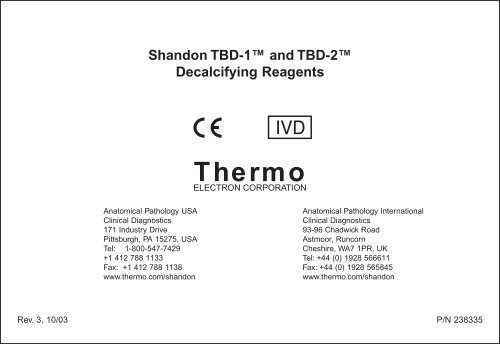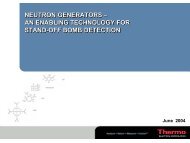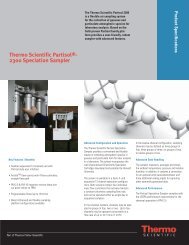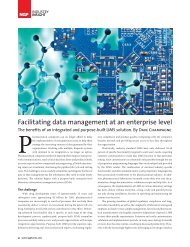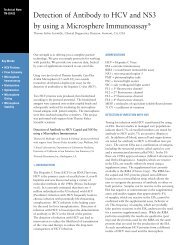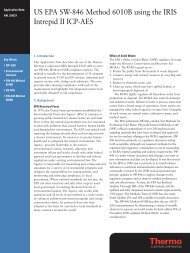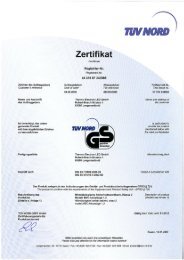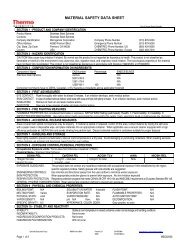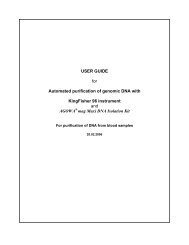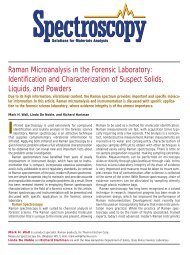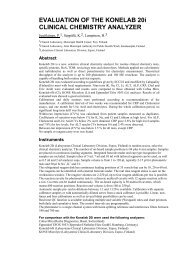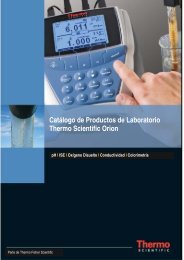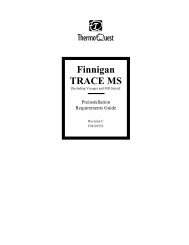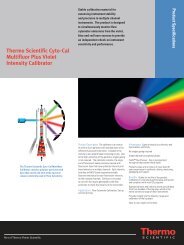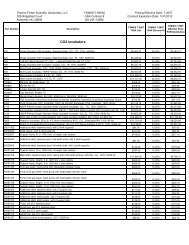Shandon TBD-1⢠and TBD-2⢠Decalcifying Reagents Thermo
Shandon TBD-1⢠and TBD-2⢠Decalcifying Reagents Thermo
Shandon TBD-1⢠and TBD-2⢠Decalcifying Reagents Thermo
You also want an ePaper? Increase the reach of your titles
YUMPU automatically turns print PDFs into web optimized ePapers that Google loves.
<strong>Sh<strong>and</strong>on</strong> <strong>TBD</strong>-1 <strong>and</strong> <strong>TBD</strong>-2<br />
<strong>Decalcifying</strong> <strong>Reagents</strong><br />
Anatomical Pathology USA<br />
Clinical Diagnostics<br />
171 Industry Drive<br />
Pittsburgh, PA 15275, USA<br />
Tel: 1-800-547-7429<br />
+1 412 788 1133<br />
Fax: +1 412 788 1138<br />
www.thermo.com/sh<strong>and</strong>on<br />
<strong>Thermo</strong><br />
ELECTRON CORPORATION<br />
Anatomical Pathology International<br />
Clinical Diagnostics<br />
93-96 Chadwick Road<br />
Astmoor, Runcorn<br />
Cheshire, WA7 1PR, UK<br />
Tel: +44 (0) 1928 566611<br />
Fax: +44 (0) 1928 565845<br />
www.thermo.com/sh<strong>and</strong>on<br />
Rev. 3, 10/03 P/N 238335
SHANDON DECALCIFYING REAGENTS<br />
The decalcifying reagents, <strong>TBD</strong>-1 <strong>and</strong> <strong>TBD</strong>-2, were designed to give the technologist a choice of decalcification methods.<br />
Most laboratories receive a wide variety of material to be decalcified. Because the decalcification time is different for each specimen,<br />
quality control is difficult in a busy laboratory. With <strong>TBD</strong>-1 <strong>and</strong> <strong>TBD</strong>-2 on h<strong>and</strong>, the technologist can now select the reagent to suit the<br />
circumstance. There is never a need to choose between quality <strong>and</strong> efficiency.<br />
<strong>TBD</strong>-1 is a rapid decalcifying agent. <strong>TBD</strong>-1 will decalcify bone marrow biopsies in as little as 15 to 30 minutes. It will also decalcify thin<br />
pieces of dense bone in 3 to 12 hours without damage to soft tissues or loss of staining properties. <strong>TBD</strong>-1 is the reagent of choice for<br />
early results <strong>and</strong> fast diagnostic work.<br />
<strong>TBD</strong>-2 is designed for safe, longer term decalcification. <strong>TBD</strong>-2 has a slower rate of reaction, which makes end-point determinations less<br />
critical.<br />
Sections of bone have been left in <strong>TBD</strong>-2 for as long as 48 hours beyond the decalcification end-point without noticeable effect. <strong>TBD</strong>-2<br />
is the reagent of choice for weekends, holidays, or when the laboratory workload does not permit close supervision of the decalcification<br />
procedure.<br />
WARNINGS AND PRECAUTIONS<br />
FOR IN VITRO DIAGNOSTIC USE.<br />
STORAGE<br />
Store at room temperature. Keep containers closed when not in use. DO NOT REUSE CONTAINER.<br />
WARNINGS AND PRECAUTIONS<br />
See Material Safety Data Sheets for warnings <strong>and</strong> precautions, as well as R & S code definitions. The following symbols are<br />
used on the product labels <strong>and</strong> packaging:<br />
Definitions are at the rear of this booklet<br />
ENGLISH
INSTRUCTIONS FOR USE<br />
<strong>TBD</strong>-1 <strong>and</strong> <strong>TBD</strong>-2 are designed to be used full strength.<br />
A. Specimen Preparation<br />
1. Bones <strong>and</strong> other calcified materials must be adequately fixed before placing them in <strong>TBD</strong> solutions. The fixative of choice is at the<br />
user’s discretion.<br />
2. Bone should be cut into sections of 3mm thickness or less.<br />
B. Procedure<br />
1. Decalcification should be done in a glass or plastic container.<br />
WARNING: DO NOT USE METAL CONTAINERS.<br />
2. Rinse excess fixative from specimen <strong>and</strong> place in <strong>TBD</strong> solution. Long washing after fixation or decalcification is not<br />
recommended.<br />
3. The volume of <strong>TBD</strong>-1 or <strong>TBD</strong>-2 should be 20 times the volume of the specimen.<br />
4. For more rapid decalcification, suspend the specimen in <strong>TBD</strong>-1 or <strong>TBD</strong>-2 <strong>and</strong> use a mechanical stirrer.<br />
WARNING: DO NOT USE HEAT.<br />
5. Any of the routine methods for determining the end-point of decalcification can be used.<br />
6. Decalcification in <strong>TBD</strong>-1 can take 15 minutes to 48 hours. Decalcification in <strong>TBD</strong>-2 can take several hours to several days.<br />
NOTE: Decalcification times vary depending on the size, thickness, density <strong>and</strong> type of specimen. More exact time limits must be<br />
based on the experience <strong>and</strong> judgement of the histotechnologist or pathologist.<br />
C. Additional Guidelines for <strong>TBD</strong>-1<br />
1. Bone marrow biopsies will be decalcified in 15 to 30 minutes. They should be checked frequently to prevent over-decalcification.<br />
2. Most bone sections larger than a bone marrow biopsy will decalcify within 3 to 24 hours. Caution must be used if the specimen<br />
will remain in <strong>TBD</strong>-1 overnight or on weekends <strong>and</strong> holidays.<br />
3. If there is a possibility of over-decalcification:<br />
a. Remove the specimen from <strong>TBD</strong>-1, rinse <strong>and</strong> return specimen to <strong>TBD</strong>-1 during workings hours.<br />
b. Use <strong>TBD</strong>-2.<br />
ENGLISH
SHANDON ENTKALKUNGSREAGENZIEN<br />
Die Entkalkungsreagenzien <strong>TBD</strong>-1 und <strong>TBD</strong>-2 wurden entwickelt, um dem Techniker eine Auswahl bei den Entkalkungsverfahren zur Verfügung<br />
zu stellen.<br />
Die meisten Laboratorien erhalten eine große Vielzahl von Material, das entkalkt werden muss. Da jede Probe eine <strong>and</strong>ere Entkalkungszeit hat,<br />
ist eine Qualitätskontrolle in einem stark ausgelasteten Labor schwierig. Mit <strong>TBD</strong>-1 und <strong>TBD</strong>-2 zur H<strong>and</strong> kann der Techniker nun das Reagenz<br />
nach den Erfordernissen der Umstände wählen. Es muss keine Entscheidung mehr zwischen Qualität und Wirksamkeit getroffen werden.<br />
<strong>TBD</strong>-1 ist ein Schnell-Entkalker. <strong>TBD</strong>-1 entkalkt Knochenmarkbiopsien in nur 15 bis 30 Minuten. Es entkalkt ebenfalls dünne Stücke dichten<br />
Knochens in 3 bis 12 Stunden ohne Schäden an den Weichteilgeweben oder Verlust der Färbungseigenschaften. <strong>TBD</strong>-1 ist das Reagenz der<br />
Wahl für schnelle Ergebnisse und schnelles diagnostisches Arbeiten.<br />
<strong>TBD</strong>-2 wurde für eine sichere Langzeit-Entkalkung entwickelt. <strong>TBD</strong>-2 hat eine niedrigere Reaktionsrate, wodurch Endpunktbestimmungen<br />
weniger kritisch werden.<br />
Knochenschnitte wurden ohne erkennbaren Effekt 48 Stunden lang über den Entkalkungsendpunkt hinaus in <strong>TBD</strong>-2 belassen. <strong>TBD</strong>-2 ist das<br />
Reagenz der Wahl für das Wochenende, die Ferien, oder wenn die Laborauslastung keine strenge Supervision des Entkalkungsprozesses<br />
zulässt.<br />
WARNHINWEISE UND SICHERHEITSMASSNAHMEN<br />
ZUR IN-VITRO-DIAGNOSTIK.<br />
LAGERUNG<br />
Bei Raumtemperatur lagern. Die Behälter bei Nichtgebrauch geschlossen aufbewahren. DEN BEHÄLTER NICHT WIEDER VERWENDEN.<br />
WARNHINWEISE UND SICHERHEITSMASSNAHMEN<br />
Die Warnhinweise und Sicherheitsmaßnahmen sind im Sicherheitsdatenblatt sowie in den R- und S-Sätzen enthalten.<br />
Folgende Symbole finden auf den Produktetiketten und der Verpackung Verwendung:<br />
Die Definitionen befinden sich auf der Rückseite der Gebrauchsanweisung.<br />
DEUTSCH
HINWEISE ZUM GEBRAUCH<br />
<strong>TBD</strong>-1 und <strong>TBD</strong>-2 sind unverdünnt zu verwenden.<br />
A. Probenpräparation<br />
1. Knochen und <strong>and</strong>ere kalkhaltige Materialien müssen vor dem Einlegen in die <strong>TBD</strong>-Lösungen adäquat fixiert werden. Das<br />
Fixiermittel der Wahl liegt im Ermessensbereich des Anwenders.<br />
2. Es sollten Knochenschnitte mit einer Dicke von höchstens 3 mm angefertigt werden.<br />
B. Verfahren<br />
1. Die Entkalkung sollte in einem Glas- oder Plastikbehälter durchgeführt werden.<br />
WARNUNG: KEINE METALLBEHÄLTER VERWENDEN.<br />
2. Das überschüssige Fixiermittel von der Probe abspülen und diese in die <strong>TBD</strong>-Lösung legen. Ein langes Waschen nach der<br />
Fixierung oder Entkalkung ist nicht empfehlenswert.<br />
3. Das Volumen von <strong>TBD</strong>-1 oder <strong>TBD</strong>-2 sollte das 20fache des Probenvolumens betragen.<br />
4. Eine schnellere Entkalkung wird durch Suspendierung der Probe in <strong>TBD</strong>-1 oder <strong>TBD</strong>-2 und Verwendung eines mechanischen<br />
Rührers erzielt.<br />
WARNUNG: KEINE HITZE ANWENDEN.<br />
5. Es kann jedes Routineverfahren zur Bestimmung des Entkalkungsendpunkts angew<strong>and</strong>t werden.<br />
6. Die Entkalkung in <strong>TBD</strong>-1 kann 15 Minuten bis 48 Stunden dauern. Die Entkalkung in <strong>TBD</strong>-2 kann mehrere Stunden bis Tage in<br />
Anspruch nehmen.<br />
HINWEIS: Die Entkalkungszeiten hängen von der Größe, Dicke, Dichte und Art der Probe ab. Genauere zeitliche Grenzen<br />
müssen auf der Erfahrung und dem Urteil des Histotechnikers oder Pathologen basieren.<br />
C. Zusätzliche Richtlinien für <strong>TBD</strong>-1<br />
1. Knochenmarkbiopsien werden in 15 bis 30 Minuten entkalkt. Sie sollten häufig überprüft werden, um eine Überentkalkung zu<br />
verhindern.<br />
2. Die meisten Knochenschnitte, die dicker als eine Knochenmarkbiopsie sind, werden in 3 bis 24 Stunden entkalkt. Wenn die Probe<br />
über Nacht oder übers Wochenende und während der Ferienzeit in <strong>TBD</strong>-1 verbleibt, muss große Vorsicht walten.<br />
3. Bei bestehender Möglichkeit einer Überentkalkung:<br />
a. Die Probe aus <strong>TBD</strong>-1 herausnehmen, spülen und erneut während der Arbeitszeit in <strong>TBD</strong>-1 legen.<br />
b. <strong>TBD</strong>-2 verwenden.<br />
DEUTSCH
REACTIVOS DESCALCIFICANTES SHANDON<br />
Los reactivos descalcificantes, <strong>TBD</strong>-1 y <strong>TBD</strong>-2, ofrecen a los tecnólogos una variedad de métodos de descalcificación.<br />
La mayoría de los laboratorios reciben una amplia variedad de material para descalcificar. Puesto que el tiempo de descalcificación es<br />
distinto para cada muestra, el control de calidad es difícil en un laboratorio de gran actividad. Con <strong>TBD</strong>-1 y <strong>TBD</strong>-2, el tecnólogo ahora<br />
puede seleccionar el reactivo que mejor se adapte a las circunstancias. Ya no hay que elegir entre calidad y eficacia.<br />
<strong>TBD</strong>-1 es un agente descalcificante rápido. Este agente descalcificará biopsias de médula ósea en tan sólo de 15 a 30 minutos. También<br />
descalcificará fragmentos finos de hueso denso en un intervalo de 3 a 12 horas sin daños en los tejidos bl<strong>and</strong>os ni pérdida de las<br />
propiedades de tinción. <strong>TBD</strong>-1 es el reactivo que debe elegirse para obtener resultados y diagnósticos rápidos.<br />
<strong>TBD</strong>-2 está concebido para una descalcificación segura a más largo plazo. <strong>TBD</strong>-2 tiene una velocidad de reacción menor, lo que hace<br />
que la determinación del punto final sea menos crítica.<br />
Se han mantenido secciones de hueso en <strong>TBD</strong>-2 durante 48 horas con posterioridad al punto final de la descalcificación sin efectos<br />
apreciables. <strong>TBD</strong>-2 es el reactivo que debe elegirse para fines de semana, vacaciones o cu<strong>and</strong>o la gran actividad del laboratorio no<br />
permita una supervisión minuciosa del procedimiento de descalcificación.<br />
ADVERTENCIAS Y PRECAUCIONES<br />
PARA USO EN DIAGNÓSTICOS IN VITRO.<br />
ALMACENAMIENTO<br />
Almacenar a temperatura ambiente. Mantener los contenedores cerrados cu<strong>and</strong>o no se utilicen. NO VOLVER A UTILIZAR LOS<br />
CONTENEDORES.<br />
ADVERTENCIAS Y PRECAUCIONES<br />
Consulte las hojas de datos de seguridad de materiales para saber las advertencias y precauciones, así como la definición de<br />
los códigos de riesgos y seguridad. En las etiquetas y envases de los productos se utilizan los siguientes símbolos:<br />
Su definición se detalla al final de este folleto.<br />
ESPAÑOL
INSTRUCCIONES DE USO<br />
<strong>TBD</strong>-1 y <strong>TBD</strong>-2 están preparados para su uso en la concentración total.<br />
A. Preparación de las muestras<br />
1. Los huesos y otros materiales calcificados deben fijarse adecuadamente antes de colocarlos en soluciones de <strong>TBD</strong>. El fijador lo<br />
elegirá el usuario a su discreción.<br />
2. El hueso debe cortarse en secciones con un grosor de 3 mm o menos.<br />
B. Procedimiento<br />
1. La descalcificación deben realizarse en un contenedor de vidrio o plástico.<br />
ADVERTENCIA: NO UTILIZAR CONTENEDORES DE METAL.<br />
2. Enjuague para quitar el fijador sobrante de la muestra y coloque ésta en una solución de <strong>TBD</strong>. No se recomienda enjuagar<br />
durante mucho tiempo después de la fijación o la descalcificación.<br />
3. La cantidad de <strong>TBD</strong>-1 o <strong>TBD</strong>-2 debe ser 20 veces la cantidad de la muestra.<br />
4. Para una descalcificación más rápida, suspenda la muestra en <strong>TBD</strong>-1 o <strong>TBD</strong>-2, y utilice un agitador mecánico.<br />
ADVERTENCIA: NO APLICAR CALOR.<br />
5. Puede emplearse cualquiera de los métodos habituales para determinar el punto final de la descalcificación.<br />
6. La descalcificación en <strong>TBD</strong>-1 puede tardar de 15 minutos a 48 horas. La descalcificación en <strong>TBD</strong>-2 puede tardar de varias horas<br />
a varios días.<br />
NOTA: Los tiempos de descalcificación varían según el tamaño, grosor, densidad y tipo de muestra. Los límites de tiempo más<br />
exactos deben basarse en la experiencia y la apreciación del histotecnólogo o patólogo.<br />
C. Directrices adicionales para <strong>TBD</strong>-1<br />
1. Las biopsias de médula ósea se descalcificarán en un intervalo de 15 a 30 minutos. Deben comprobarse con frecuencia para<br />
evitar una descalcificación excesiva.<br />
2. La mayoría de las secciones de hueso mayores que una biopsia de médula ósea se descalcificarán en un intervalo de 3 a 24<br />
horas. Deben tomarse las debidas precauciones si la muestra va a permanecer en <strong>TBD</strong>-1 durante la noche o en fines de semana<br />
y vacaciones.<br />
3. Si puede producirse una descalcificación excesiva:<br />
a. Retire la muestra de la solución de <strong>TBD</strong>-1, enjuague y vuelva a colocarla en <strong>TBD</strong>-1 durante las horas de trabajo.<br />
b. Utilice <strong>TBD</strong>-2.<br />
ESPAÑOL
REACTIFS DECALCIFIANTS DE SHANDON<br />
Les réactifs décalcifiants, <strong>TBD</strong>-1 et <strong>TBD</strong>-2, ont été conçus pour donner au technicien le choix entre plusieurs méthodes de<br />
décalcification.<br />
La plupart des laboratoires reçoivent une gr<strong>and</strong>e variété de matériaux à décalcifier. Etant donné que le temps de décalcification est<br />
différent pour chaque échantillon, il est difficile d’effectuer un contrôle qualité dans un laboratoire surchargé. Le technicien qui a le<br />
<strong>TBD</strong>-1 et le <strong>TBD</strong>-2 à sa disposition peut désormais sélectionner le réactif le mieux adapté. Il ne doit jamais faire un choix entre qualité<br />
et efficacité.<br />
Le <strong>TBD</strong>-1 est un agent décalcifiant rapide. Il ne lui faut pas plus de 15 à 30 minutes pour décalcifier les biopsies de moelle osseuse. Il<br />
décalcifie également de fines coupes d’os dense en 3 à 12 heures sans endommager les tissus mous ou occasionner une perte des<br />
propriétés de coloration. Le <strong>TBD</strong>-1 est le réactif idéal pour obtenir des résultats précoces et effectuer un diagnostic rapide.<br />
Le <strong>TBD</strong>-2 est indiqué pour une décalcification sûre et à plus long terme. Sa vitesse de réaction est inférieure. La détermination des points<br />
de virage est donc moins critique.<br />
Des coupes d’os ont été laissées dans du <strong>TBD</strong>-2 jusqu’à 48 heures, au-delà du point de virage de décalcification, sans obtenir d’effet<br />
remarquable. Le <strong>TBD</strong>-2 est le réactif idéal pour les fins de semaine, les congés ou lorsque la charge de travail du laboratoire ne permet<br />
pas une surveillance étroite de la procédure de décalcification.<br />
AVERTISSEMENTS ET PRECAUTIONS<br />
POUR UN USAGE DIAGNOSTIQUE IN VITRO.<br />
CONSERVATION<br />
Conserver à température ambiante. Garder les récipients fermés lorsqu’ils ne sont pas utilisés. NE PAS RÉUTILISER UN RÉCIPIENT.<br />
AVERTISSEMENTS ET PRECAUTIONS<br />
Se reporter aux avertissements et précautions des fiches toxicologiques, ainsi qu’aux définitions de codes R et S qu’elles<br />
contiennent. Les symboles utilisés sur les étiquettes et les emballages des produits sont les suivants :<br />
Leurs définitions figurent au dos de cette brochure.<br />
FRANÇAIS
NOTICE D’UTILISATION<br />
Le <strong>TBD</strong>-1 et le <strong>TBD</strong>-2 sont conçus pour être utilisés purs.<br />
A. Préparation des échantillons<br />
1. Les os et autres matériaux calcifiés doivent être correctement fixés avant d’être placés dans des solutions de <strong>TBD</strong>. Le fixateur<br />
idéal est à la convenance de l’utilisateur.<br />
2. L’os doit être sectionné en coupes de 3 mm d’épaisseur au maximum.<br />
B. Procédure<br />
1. La décalcification doit être effectuée dans un récipient en verre ou en plastique.<br />
AVERTISSEMENT : NE PAS UTILISER DE RÉCIPIENTS MÉTALLIQUES.<br />
2. Rincer l’excédent de fixateur présent dans l’échantillon et le placer dans la solution <strong>TBD</strong>. Un lavage prolongé après la fixation ou<br />
la décalcification n’est pas recomm<strong>and</strong>é.<br />
3. Le volume de <strong>TBD</strong>-1 ou de <strong>TBD</strong>-2 doit être 20 fois supérieur à celui de l’échantillon.<br />
4. Pour une décalcification plus rapide, mettre l’échantillon en suspension dans le <strong>TBD</strong>-1 ou le <strong>TBD</strong>-2 et utiliser un agitateur<br />
mécanique.<br />
AVERTISSEMENT : NE PAS CHAUFFER.<br />
5. N’importe quelle méthode de routine peut être utilisée pour la détermination du point de virage de décalcification.<br />
6. La décalcification dans le <strong>TBD</strong>-1 peut prendre de 15 minutes à 48 heures. La décalcification dans le <strong>TBD</strong>-2 peut prendre plusieurs<br />
heures à plusieurs jours.<br />
REMARQUE : Les temps de décalcification peuvent varier en fonction de la taille, de l’épaisseur, de la densité et du type de<br />
l’échantillon. Seuls le jugement et l’expérience de l’histologiste ou du pathologiste permettent de déterminer des délais plus précis.<br />
C. Recomm<strong>and</strong>ations supplémentaires pour le <strong>TBD</strong>-1<br />
1. Les biopsies de moelle osseuse seront décalcifiées en 15 à 30 minutes. Elles doivent être contrôlées fréquemment pour éviter<br />
une décalcification excessive.<br />
2. La plupart des coupes osseuses plus gr<strong>and</strong>es qu’une biopsie de moelle osseuse seront décalcifiées en 3 à 24 heures. Prendre<br />
des précautions si l’échantillon doit rester dans le <strong>TBD</strong>-1 jusqu’au lendemain ou pendant des fins de semaine ou des congés.<br />
3. Si un risque de décalcification excessive existe :<br />
a. Retirer l’échantillon du <strong>TBD</strong>-1, le rincer et le replacer dans le <strong>TBD</strong>-1 pendant les heures ouvrées.<br />
b. Utiliser le <strong>TBD</strong>-2.<br />
FRANÇAIS
REAGENTI DECALCIFICANTI SHANDON<br />
I reagenti decalcificanti <strong>TBD</strong>-1 e <strong>TBD</strong>-2 sono stati concepiti per offrire al tecnico di laboratorio una selezione di metodi di decalcificazione.<br />
Alla maggior parte dei laboratori perviene un’ampia varietà di materiali da decalcificare. Poiché il tempo di decalcificazione varia da<br />
campione a campione, il controllo qualità risulta di difficile implementazione in un laboratorio oberato di lavoro. <strong>TBD</strong>-1 e <strong>TBD</strong>-2 offrono<br />
al tecnico di laboratorio la possibilità di scegliere il reagente più adatto alle circostanze specifiche. Non si pone mai, dunque, l’esigenza<br />
di scegliere tra qualità ed efficienza.<br />
<strong>TBD</strong>-1 è un agente decalcificante ad azione rapida. <strong>TBD</strong>-1 decalcifica le biopsie midollari in meno di 15 - 30 minuti. Inoltre, è in grado<br />
di decalcificare sottili sezioni ossee compatte in 3 - 12 ore senza danneggiare i tessuti molli o compromettere le caratteristiche di<br />
colorazione. <strong>TBD</strong>-1 è il reagente di elezione grazie alla rapidità dei risultati e del lavoro diagnostico.<br />
<strong>TBD</strong>-2 è stato concepito per una decalcificazione sicura e a lungo termine. <strong>TBD</strong>-2 ha una velocità di reazione più lenta, rendendo meno<br />
critica la determinazione del punto finale.<br />
Sezioni ossee sono state lasciate riposare in soluzione <strong>TBD</strong>-2 per le 48 ore successive al punto finale di decalcificazione senza effetti<br />
di rilievo. <strong>TBD</strong>-2 è il reagente di elezione per i fine settimana, i periodi di ferie oppure ogniqualvolta il carico di lavoro del laboratorio non<br />
consenta un’attenta supervisione della procedura di decalcificazione.<br />
AVVERTENZE E PRECAUZIONI<br />
PER USO DIAGNOSTICO IN VITRO.<br />
CONSERVAZIONE<br />
Conservare a temperatura ambiente. Mantenere i contenitori chiusi qu<strong>and</strong>o non vengono utilizzati. NON RIUTILIZZARE IL<br />
CONTENITORE.<br />
AVVERTENZE E PRECAUZIONI<br />
Per Avvertenze e Precauzioni, consultare le Schede di sicurezza e le definizioni di codice R & S. Su etichette e confezione del<br />
prodotto sono utilizzati i simboli seguenti:<br />
Le definizioni sono riportate sul retro del presente opuscolo<br />
ITALIANO
ISTRUZIONI PER L’USO<br />
<strong>TBD</strong>-1 e <strong>TBD</strong>-2 devono essere utilizzati non diluiti.<br />
A. Preparazione del campione<br />
1. Sottoporre a un adeguato fissaggio il materiale osseo e gli altri materiali calcificati prima di trasferirli in soluzioni <strong>TBD</strong>. Il fissativo<br />
di elezione è a discrezione dell’utente.<br />
2. Tagliare il materiale osseo in sezioni di spessore pari o inferiore a 3 mm.<br />
B. Procedura<br />
1. È opportuno eseguire la decalcificazione in un contenitore di vetro o plastica.<br />
AVVERTENZA: NON UTILIZZARE CONTENITORI METALLICI.<br />
2. Eliminare il fissativo in eccesso dal campione mediante risciacquo e trasferire in soluzione <strong>TBD</strong>. Si sconsiglia un lavaggio<br />
prolungato dopo il fissaggio o la decalcificazione.<br />
3. Il volume di <strong>TBD</strong>-1 o <strong>TBD</strong>-2 deve corrispondere a 20 volte il volume del campione.<br />
4. Per una decalcificazione più rapida, sospendere il campione in <strong>TBD</strong>-1 o <strong>TBD</strong>-2 e utilizzare un agitatore meccanico.<br />
AVVERTENZA: NON UTILIZZARE IL CALORE.<br />
5. È possibile utilizzare tutti i comuni metodi di determinazione del punto finale della decalcificazione.<br />
6. La decalcificazione in soluzione <strong>TBD</strong>-1 può richiedere da 15 minuti a 48 ore. La decalcificazione in soluzione <strong>TBD</strong>-2 può richiedere<br />
da alcune ore a più giorni.<br />
NOTA: I tempi di decalcificazione variano in base alle dimensioni, allo spessore, alla densità e al tipo di campione. Limiti temporali<br />
più specifici devono essere determinati in base all’esperienza e al giudizio del tecnico istologo o del patologo.<br />
C. Istruzioni supplementari per <strong>TBD</strong>-1<br />
1. Le biopsie midollari vengono decalcificate in 15 - 30 minuti. Eseguire controlli frequenti per prevenire una decalcificazione<br />
eccessiva.<br />
2. La maggior parte delle sezioni ossee di dimensioni superiori a una normale biopsia midollare vengono decalcificate entro 3 - 24<br />
ore. Procedere con cautela nei casi in cui il campione venga lasciato nella soluzione <strong>TBD</strong>-1 di notte, durante i fine settimana o<br />
periodi di ferie.<br />
3. Se esiste il rischio di decalcificazione eccessiva:<br />
a. Rimuovere il campione dalla soluzione <strong>TBD</strong>-1, sciacquarlo e trasferirlo nuovamente nella soluzione <strong>TBD</strong>-1 in orario lavorativo.<br />
b. Utilizzare <strong>TBD</strong>-2.<br />
ITALIANO
ORDER INFORMATION<br />
Product Unit REF<br />
<strong>TBD</strong>-1 1.0 Liter 6764001<br />
<strong>TBD</strong>-1 4.0 Liter 6764002<br />
<strong>TBD</strong>-2 1.0 Liter 6764003<br />
<strong>TBD</strong>-2 4.0 Liter 6764004<br />
Refer to Manual For In Vitro<br />
Diagnostic Use<br />
Lot Number Product Number Corrosive Store Between<br />
15-25º<br />
<strong>Thermo</strong> Electron Corporation Anatomical Pathology has realized since its beginnings the value of in-house assistance. If you have questions about<br />
ordering, shipping, delivery, inventory status or pricing, just phone our Customer Service Department toll-free at 1-800-547-7429 in the U.S., or our direct<br />
subsidiaries in the UK, France, Germany <strong>and</strong> Australia. Our technical support staff consists of certified Cytotechnologists <strong>and</strong> Histologists.


